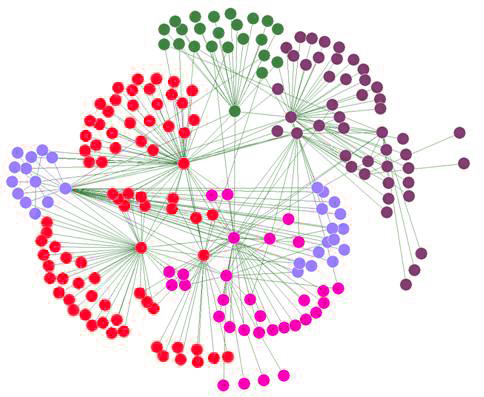Social Networks ? Social Directories !
vs
 All "social network services" have technically started out as list of names - people directories. Each person file has fields like name, age, interests etc. In that they are modern versions of phone books or telephone directories which offer extended information about a person, professional data traditionally called a CV and personal info, such as interests, hobbies, likes and dislikes, personal historic data. And the predecessors of the now called social network services were naming themselves just that, for example "the facebook", the digital version of a college "yearbook".
All "social network services" have technically started out as list of names - people directories. Each person file has fields like name, age, interests etc. In that they are modern versions of phone books or telephone directories which offer extended information about a person, professional data traditionally called a CV and personal info, such as interests, hobbies, likes and dislikes, personal historic data. And the predecessors of the now called social network services were naming themselves just that, for example "the facebook", the digital version of a college "yearbook".
The next design task was to manage the access to that information. Who is allowed to create a record, who is allowed to edit that data and for social network services most important, who is allowed to read a record, or parts of that and to add some additional info such as a comment, a link or a photo.
 Who is allowed what and to whom do I relate to, family wise, professionally and socially, that are nowadays the most important features of social network services.
Who is allowed what and to whom do I relate to, family wise, professionally and socially, that are nowadays the most important features of social network services.But - those are in fact by design not social network services, but more accurately social directory services.
 A network concentrates on connecting the nodes, a directory of that network would simply list nodes in a network. Designing a network is looking at the connection, the link, the communication. That is done through links, cables, tunnels, streets, rails, pipelines, routes, veins, arteries, stairs, corridors, lifts / elevators. Each follows codes, rules, protocols and regulations which allow some kind of transportation or flow.
A network concentrates on connecting the nodes, a directory of that network would simply list nodes in a network. Designing a network is looking at the connection, the link, the communication. That is done through links, cables, tunnels, streets, rails, pipelines, routes, veins, arteries, stairs, corridors, lifts / elevators. Each follows codes, rules, protocols and regulations which allow some kind of transportation or flow.You wouldn't call a house a network, though a network of media might run through a building.A big building has a directory, the list of names of companies or occupants and may even offer a direct "access" - buzzer. A town is usually not designated as a network, however the streets connecting the houses form a network.

In the same way is a social network service basically a directory of nodes - us, the people. Therefore we should call Facebook, LinkedIn etc what they really are: social directory services.
 Social Networks are social structures of actors and the ties between the actors. Pictures of those can only be representations of fragments of these structures. If you were to design a social network, you would need to focus on the network aspect, concentrating on how people connect to each other, what rules to follow, how to scale. You create building blocks rather than a walled garden. Starting by creating the people database is saddling the horse from behind. The directory should be like a read out, a momentary scan of the network.
Social Networks are social structures of actors and the ties between the actors. Pictures of those can only be representations of fragments of these structures. If you were to design a social network, you would need to focus on the network aspect, concentrating on how people connect to each other, what rules to follow, how to scale. You create building blocks rather than a walled garden. Starting by creating the people database is saddling the horse from behind. The directory should be like a read out, a momentary scan of the network. One of the rare exceptions of real digital social networks might be communication services like for example email services or Twitter. Those were designed based on network and communication protocols first.
One of the rare exceptions of real digital social networks might be communication services like for example email services or Twitter. Those were designed based on network and communication protocols first.And the fact that services like Facebook and LinkedIn are designed as directories, and not open networks, might be their biggest economic threat - rather than the next direct competitor.
Hierarchical Tree Structure: National Cancer Institute NCI https://wiki.nci.nih.gov/display/caCORE/Hierarchical+Tree+Structure+v4.3
Social Network Graph: Picture of Wikipedia, Daniel Tenerife, Ejemplo de diagrama de una red social http://en.wikipedia.org/wiki/File:Social_Red.jpg
Fernandodosantos, Lista telefônica Guia Fácil, edição de Blumenau para o ano de 2012 http://commons.wikimedia.org/wiki/File:Lista-telefonica.png
London Underground, en.wikipedia.org/wiki/File:TubeMapZ1_TFL.pngIntercom: Waldemar Gminski http://commons.wikimedia.org/wiki/File:Kaseta_4lx-15nr.jpg
Stages in the self-organization of a network, based on Nagler, J., Levina, A., & Timme, M. (2011). Impact of single links in competitive percolation by Takemori39, http://en.wikipedia.org/wiki/File:Network_self-organization_stages.png
Network Overlay vy Ludovic Ferre http://en.wikipedia.org/wiki/File:Network_Overlay.svg
The Opte Project http://en.wikipedia.org/wiki/File:Internet_map_1024.jpg


Comments